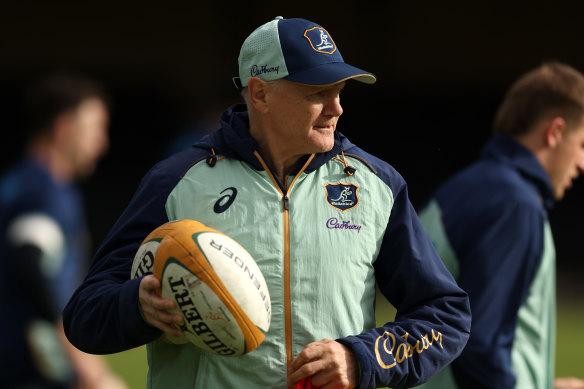Opinion
Inventive Irish show that Wallabies’ narrow attack isn’t a problem in itself
Paul Cully
Rugby columnistJoe Schmidt’s relatively narrow attack will be the stick that will be used to beat him if the Wallabies don’t make improvements this year, starting with the Test against Argentina in La Plata this weekend.
While selections, or non-selections, have been the source of discontent at former Wallabies coaches, Schmidt’s attacking structure has prompted mumblings of discontent.
But the narrowness of the attack is not the problem, per se. In fact, a relatively condensed shape is not inconsistent with creativity or innovation in itself, a fact shown when Ireland in July twice bamboozled the Springboks through the middle of the field by actually overloading their three-man pod system with an extra body.
The two issues with the Wallabies are that they haven’t yet consistently shown enough variety or efficiency with their short passing game, compounded by the lack of decisiveness from the No.10, or the backline as a whole, to call for the ball.
The latter was identified by former Wallabies halfback Nick Phipps in Stan’s Between Two Posts podcast, when he lamented the fact that he didn’t see any “trigger” plays from the Wallabies backline until about 50 minutes into the second Test against the Springboks.
The remark has flown a little under the radar, but it goes to heart of the issue and is related to another observation by England No.10 George Ford about how backlines sometimes simply need to front up and call for the ball, even though they mightn’t have the numbers or the obvious overlap.

Wallabies coach Joe Schmidt looks on during a training session.Credit: Getty
But if we go back to those Ireland-Springboks Tests, one particular play from the Irish worked two weeks in a row and showed that an apparently narrow attack can be the best weapon against modern defences, which love to jam in from the outside.
The Irish tricked South Africa twice by showing them a very familiar picture - the common three-man forward pod taking the ball to the line - before injecting a fourth runner who was hiding in behind them with a deeper run.
The Springboks defenders did what they’ve been practising for years: they covered the men on the edge of the three-man pod, and when those Irish runners ran just the smallest decoy line to seem like they were looking for an outside shoulder, the ball was dropped in behind to the fourth man who ran through a gap like the parting of the Red Sea.
It was the latest example from Ireland that manipulation of defenders in tight spaces has become their calling card. It is brilliantly effective because it kills defensive line speed: in fact it turns it into a weakness because if you pierce a rush defence up the middle the outsides have no chance of getting back to scramble.
So, a narrow attack is not the problem - it’s the accompanying lack of deception, and we can see from the Wallabies that they are in the early stages of trying to get to where Ireland are. They certainly have some forwards capable of offering that late disguise at the line - new captain Harry Wilson is very good at it - but the effectiveness of the shape is in the repetition of running lines until it becomes second nature.
The other issue - the No.10 not demanding the ball - can be traced back to the first Test against Wales. In that game, the Wallabies did some excellent work on attack and Noah Lolesio looked to be more prominent than he has been subsequently.
But there were a few red flags at the start of the second half, when the Wallabies became a little bit ‘one out’ with their runners, and the Welsh actually turned them over when the Wallabies were in a good attacking position.
What was beginning to look like a real problem was solved, however, when Lolesio called the play that eventually led to Filipo Daugunu’s try. That’s got to be Lolesio’s benchmark in terms of taking control, and in fact I’d like to see him and the backline be collectively more assertive in asking for the ball to take the pressure off their forwards.
This was the point made forcefully by Ford - there are times during the game when the forwards are going to run into staunch defence, but the backs can’t always sit back waiting for lightning-quick ball or a four-on-three.
The Wallabies backline has been just a bit gun-shy at times, which leads to more (normally futile) efforts from the forwards to somehow generate momentum, creating that “bunched” look in the Wallabies attack.
Of course, the backs always run the risk of being turned over if they call for it at the wrong time, but the option does create a bit of natural width, moves the defence around and - quite frankly - stops the piggies from wondering what the backs are actually doing all day.
There are teething problems with the Wallabies attack, but it’s not the shape itself that is the root of all evil.
Sports news, results and expert commentary. Sign up for our Sport newsletter.